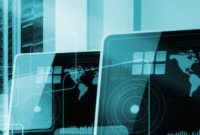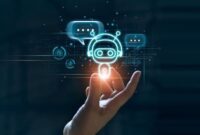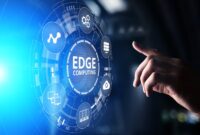
However, this has only just begun and the technological trends of 2024 are full of “old acquaintances” that are evolving, and the latest advances that will further transform our day to day, the way we relate and work.
Despite the great variety of technological advances for 2024, they all have the same common denominator: tools and advances focused on continuing to drive digitization and increase the efficiency and growth of all types of companies. The adoption of digital environments has become key for both productivity and customer loyalty.
Next, we review the technological trends that will mark 2024 and that you should not lose sight of.
- 1 Automation and Hyperautomation
- 2 Metaverse
- 3 New convolutional neural network architectures: ConvNext
- 4 Predictive Analytics
- 5 Edge Computing and native clouds
- 6 distributed companies
- 7 Low-Code Services
- 8 Decision Intelligence
- 9 Total Experience (TX)
- 10 Computer Vision and Pattern Recognition
- 11 Data Fabric
- 12 Sustainable Tech Trends
- 13 NFT (Non-Fungible Tokens) with Artificial Intelligence
Automation and Hyperautomation
Automation allows us to speed up the time spent on all kinds of tasks and increase the precision with which we perform them. 2024 is a year in which tools and developments designed to speed up the process of endless tasks, improve our effectiveness when performing them and continue freeing ourselves from those that can be fully automated, will continue to be deployed, so that we can dedicate ourselves only to those that we can provide a differential value. And hyperautomation will help improve decision-making, without losing quality, exponentially increasing speed and reducing operating costs by up to 30%.
According to expert, the global market for software that will handle automation will reach $600 billion by 2024.
Metaverse
We couldn’t not mention it in this compilation of trends, since it has been positioned as the mega trend that will define a new era and that will be able to achieve the same impact that the Internet had.
This digital universe where physical and virtual reality mix in a shared online space is going to completely change the way we work, shop, communicate and have fun. The metaverse is going to give companies great opportunities, ranging from increasing their social presence, to office work, payments, health, buying and selling products, etc.
Multinational giants such as Facebook (which has already changed its name to Meta), Zara, Epic Games or Microsoft are just some of the examples of companies that have joined this trend and will be the great promoters of this new universe. There is still work to be done to see 100% what is going to be achieved, but we must not lose sight of it.
New convolutional neural network architectures: ConvNext
The irruption of Transformers in the field of computer vision has improved the ability of neural networks to extract features from images, as well as the possibility of modeling long-range dependencies. This has led to an increase in the success rate in classification, object detection and image segmentation tasks.
Thanks to the techniques learned in the development of hybrid architectures that use “Vision Transformers”, many research groups have presented new topologies that change the traditional way in which we used convolutional neural networks. This is the case of the new network presented by Facebook research: A ConvNet for the 2020s called ConvNext, which has outperformed the “Vision Transformers” architectures in results (ImageNet Benchmark) using only convolutional neural networks.
Predictive analytics
It’s not new to the trending charts, but it deserves to make a comeback in 2024 because predictive analytics tools will continue to be game changers across industries.
If we talk about efficiency, Predictive Analytics plays a crucial role in data analysis and consolidation of data lakes and, without a doubt, it will be at the top of new projects, especially in the IT ecosystem. Furthermore, it will be crucial in driving IoT technology and cybersecurity.
Edge computing and native clouds
We are at a time when the needs of sovereignty and edge computing have accelerated the adoption of the cloud in organizations around the world. Cloud-native platforms are going to play a key role over the next year, accounting for 95% of new digital initiatives within 3 years.
The companies that have already joined this cloud model have seen how they have completely transformed their business, as well as their operating and governance models. Edge Computing is designed to counteract the centralization of the cloud, in addition to bringing capabilities and resources closer to users in real time.
Distributed companies
Many companies are still in a time of transition or adaptation to hybrid work models. The pandemic has meant that a large number have been forced to assume them forcibly, but the decision to keep them over time is a movement that is being carried out thoughtfully and firmly. The increase in remote or mixed models has made this evolution to distributed work gain a lot of force globally.
The benefits of these distributed business models are already being seen, with revenue growth expected to be 25% faster than the competition staying on traditional models.
Low-Code Services
We are moving towards the democratization of data and technology, so it was to be expected that one of the great tech trends of 2024 would be low-code services. In recent years, we have seen how skills and tools at the service of innovation have been made available to a growing number of society.
The lack of experience or knowledge has been the trigger to popularize “low-code” solutions that, together with AI and IoT infrastructures, are becoming more common among companies that do not have a single server or their own cognitive code. Therefore, these low-code interfaces will gain ground.
Decision Intelligence
The so-called “decision intelligence” gives a practical approach in decision making to improve them. Its function is to model each decision as a set of processes, supported by intelligence and analytics to learn, inform and refine these decisions.
It is the perfect complement to support human decisions and then automate them through the use of augmented analysis, simulations and Artificial Intelligence.
Total Experience (TX)
The Total Experience is a business strategy that integrates the experience of the worker, the customer, the user and, as a novelty, the multi-experience in many points of contact.
The main characteristic of the total experience is that it promotes greater trust, satisfaction, loyalty and promotion of customers and employees, offering a total management of experiences. This combination of all the “Xs” will mark the potential to improve business results, accelerating growth.
Computer Vision and pattern recognition
Computer Vision or Computer Vision continues to advance and present significant advances. We are finding more and more use cases in which this technology is helping to improve the service of many businesses.
This unlocking of information arising from the translation of images and videos is having a great impact on consumers, but it has only just begun. In the field of telemedicine or security, it has innumerable applications, such as the detection of conditions.
Data Fabric
Data Fabric, also known as data fabric, provides flexible and robust integration of data sources across an enterprise’s platforms and users. It allows data to be available anywhere, adapting to the place where it is needed.
Another of its features is that it can use analytics to autonomously learn and recommend where it should be used or modified. This is a breakthrough, as it can result in a 70% reduction in data management efforts.
Sustainable technology trends
We have left it for last, but not because it is the least important, quite the opposite. It could be classified as a trend in itself that encompasses many others, and in recent months we have seen how there has been a great change of course in business models.
Many companies have chosen to make small and large changes in their companies, paying special attention to reducing CO2 emissions (with Blockchain for example), migrating to the cloud, clean technologies for processes and products, optimization of processes and consumption, recycling, importance of metrics, etc.
*Extra Trend
NFT (Non-Fungible Tokens) with Artificial Intelligence
NFTs are digital assets that are transforming the online market, allowing the revaluation of products or goods that, until now, had circulated on the network for free.
The Internet has made content easier to consume, but also more difficult to protect. Thanks to NFTs, blockchain-based records that show the digital ownership of different items such as art, collectibles or music, allow creators to access new technologically sophisticated revenue streams and interact with users and fans in innovative ways.
In addition, one of the big trends this year is going to be the use of Artificial Intelligence for the creation of NFTs. Models such as GAN’s (Generative Adversarial Networks) are capable of generating new content once they have been trained with the appropriate data set. These networks can generate unique and exclusive works of art, which makes them very attractive within the field of NFTs.
Remember! If you want to be up to date with all the technological news, you can subscribe to our monthly newsletter so you don’t miss anything and access news, events, webinars… before anyone else.




